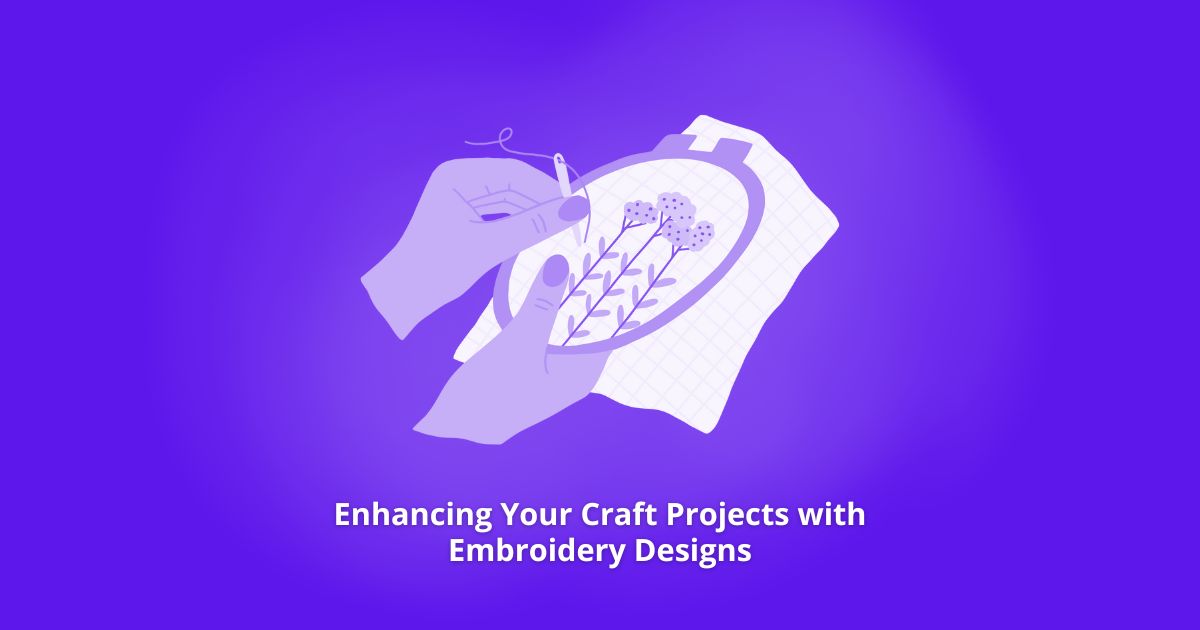Whether you’re an experienced crafter or a beginner looking for fresh ideas, incorporating embroidery designs into your projects offers endless creative possibilities. Embroidery designs not only add charm and uniqueness to your crafts but also bring an element of personalization that truly makes projects stand out.

Understanding the Basics of Embroidery Designs
Embroidery involves decorating fabric or other materials with needle and thread. The technique allows artisans to create intricate and artistic designs that range from elegant to whimsical. Sana Noor, an expert in crafting and blogger at CreativeFabrica, highlights embroidery’s versatility and practicality in her comprehensive post, “Embroidery Stitchery and Stenciling”:
“Embroidery, stitchery, and stenciling are all types of decorative needlework often used in creating quilts or other artworks. If you’re looking for an eye-catching way to decorate your home or design an art project of your own, you might want to consider using these decorative skills in your next endeavor.”
According to Noor, embroidery’s charm lies in its capacity to transform ordinary fabric into extraordinary works of art. Whether you’re stitching by hand or using a machine, the detailed nature of embroidery makes each piece uniquely appealing.
Embroidery designs are immensely valuable in crafting for several compelling reasons. First, embroidery provides lasting durability. Unlike printed patterns, embroidered designs withstand the test of time, wear, and repeated washings, making them perfect for heirloom-quality items.
Second, embroidery can greatly enhance visual and tactile appeal. The textured designs are not just visually striking; they also add depth and dimension to the fabric, creating an engaging tactile experience.
Finally, embroidery offers a level of customization unmatched by other decorative techniques. From personalized initials and monograms to complex artwork, embroidery enables crafters to execute highly personalized and detailed designs tailored precisely to individual tastes and requirements.
How Embroidery Works: A Closer Look
Embroidery designs are typically executed through various stitching techniques, each contributing to the overall visual impact:
-
Satin Stitch: Ideal for filling smaller areas and creating smooth, shiny, and solid textures.
-
Backstitch: Commonly used to outline designs or add fine details.
-
French Knot: Perfect for adding decorative accents and creating delicate, raised textures.
-
Cross Stitch: Widely favored for traditional, pixel-like effects and versatile for various patterns.
Embroidery can be executed either by hand, providing a unique, artisanal look, or by machine, enabling precision, uniformity, and faster production for larger or repetitive projects.
Practical Applications for Embroidery Designs
The beauty of embroidery lies in its versatility across many crafting domains. Embroidery designs can significantly enhance various creative projects, including but not limited to:
-
Personalized Clothing: From jackets and hats to jeans and dresses, embroidery allows the incorporation of monograms, patterns, and custom artwork that reflect individual personality and style.
-
Home Décor: Embroidered accents on pillowcases, cushions, curtains, and tablecloths provide a sophisticated touch, making everyday items exceptional. Intricate embroidery designs can transform simple household textiles into standout decorative pieces.
-
Special Occasions and Gifts: Embroidery lends itself beautifully to creating meaningful gifts, such as embroidered wedding handkerchiefs, birth announcements on blankets, or commemorative patches.
-
Business Branding: Custom embroidery on uniforms, promotional apparel, and merchandise elevates a brand’s professional image and fosters recognition.
How to Get Started with Embroidery Designs
Embroidery can initially seem daunting due to the perceived complexity of its stitches and techniques. However, as Sana Noor mentions in her insightful blog post, “Embroidery Stitchery and Stenciling”:
“Both embroidery and stenciling are great ways to create beautiful, intricate designs. With embroidery, the possibilities are virtually endless, as the needlework can be adapted to various skill levels, allowing beginners to start simple and progressively take on more intricate patterns as their skills grow.”
To start your embroidery journey, consider these straightforward steps:
- Gather Supplies: Begin with basic supplies such as embroidery hoops, needles, floss threads, scissors, and fabric.
- Choose Simple Patterns: Start with beginner-friendly patterns that involve basic stitches to build confidence and foundational skills.
- Practice Regularly: Dedicate consistent time to practice your stitches, gradually building complexity and intricacy.
- Explore Online Resources: Leverage free patterns, tutorials, and online communities to expand your skills and gain inspiration.
Tips for Successful Embroidery Projects
To make the most of your embroidery efforts, keep these essential tips in mind:
- Select High-Quality Materials: Invest in high-quality threads and fabric, as these will significantly impact your project’s final appearance.
- Maintain Proper Tension: Ensure your embroidery hoop maintains appropriate fabric tension to prevent puckering and distortion.
- Practice Regularly: Like any skill, embroidery improves significantly with consistent practice.
- Embrace Mistakes: View mistakes as opportunities for learning and creativity; often, minor errors can inspire innovative solutions or enhancements.
By regularly practicing embroidery, you’ll notice substantial improvements in both your skills and creative outcomes, transforming basic projects into remarkable art pieces.
Final Thoughts
Embroidery designs provide an incredible means for individuals looking to elevate their crafts, personalize gifts, and add artistic depth to everyday items. With numerous practical applications, embroidery remains a rewarding, enriching craft accessible to beginners and rewarding for seasoned artists alike. Embark on your embroidery journey today and discover the limitless potential of this timeless art form.